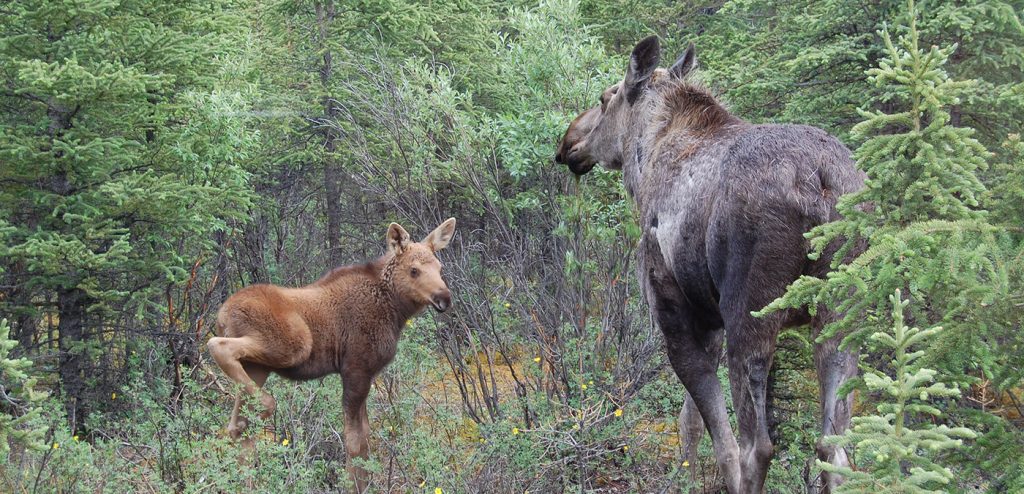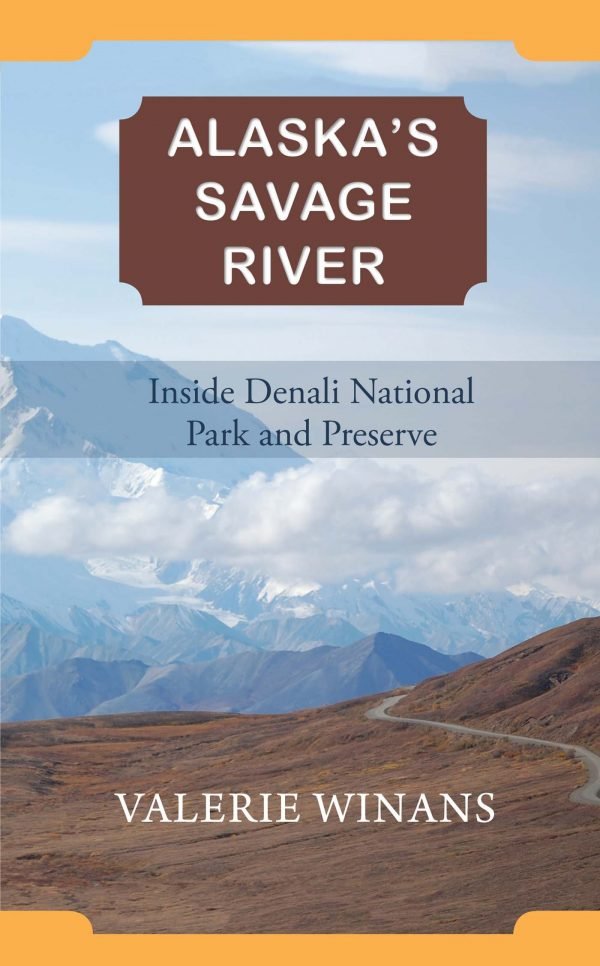Alaska’s Savage River
Inside Denali National Park and Preserve
By Valerie Winans
A Writer for Readers of All Ages
Chapter Two
Savage Campground

Within a national park larger than some countries, there is much to see and do. The confluence of Jenny Creek and Savage River is a very special place in an abundance of special places – it is magical. People are attracted to this place as if pulled by primordial forces. Hundreds of years ago, the people of the interior undoubtedly traveled through, hunted, fished, and camped here – as they do today. It is the first site where visitors camped and viewed “the mountain.”
The bluff that overlooks the river at the end of the Savage River Campground provides a view of the mountain called Fang where the glacier feeding the river originates. About a mile and a half downstream is the terminus of the glacier. The Savage River Bridge is there, and from that spot, and from almost anywhere on the Savage Loop Trail, a visitor can get a panoramic view of the Savage River valley. It’s hard to imagine a glacier filling up that valley! As the glacier melted, the size and force of the river must have been savage indeed. In the spring, the river is fast-moving and filled with silt from the glacier, but in the fall it gets shallower and clearer. However, the river doesn’t get its name from its nature – it gets it from a man.
This brave man came to Alaska in search of gold. Thomas Strand was a Snohomish Indian from the state of Washington. He worked in the mines for various miners who had filed claims, and that is when he began to be called Tom Savage. Although it would be an insult in our culture today, it was not given much importance in those days. He even filed some gold claims under the name Tom Savage; so he must not have minded the name too much. After he stopped working in the mines, Tom hunted and trapped the Savage Fork area – to the extent that people started calling the river Savage’s river. Tom eventually married and raised a family near the community of Ferry, Alaska. Tom’s grave is in a family cemetery near Ferry, a tribute to the man who left his mark and his nickname for posterity.
Savage River Campground is the second camp you will encounter as you travel along the park road. It is 12.8 miles from the highway called Parks Highway. It is rustic. There is no electricity, although water is accessible from pumps placed throughout the park. There are two bathrooms with running cold water and flush toilets and two pit toilets. If you can move beyond the luxury of a hot shower and full hookups, there are wonders to behold and lessons to be learned. The campsites are in a pocket of spruce trees situated near the tree line. As you near mile 12.8 on the park road, the river valley opens up for a view that will astound. The hard, rocky ground takes you to the river, but if you leave the taiga and venture across the tundra you will soon learn what muskeg is.
Our vocabulary and geographical knowledge increased each day as Dave and I explored our new habitat. Taiga is a Russian word meaning evergreen forest. Black spruce, with its straight, tall, skinny trunks and spindly, short branches are common on the taiga. There is also aspen, birch, and poplar in the boreal forest found below the tree line. Tundra comes from the Finnish word tunturi which means treeless. Various kinds of plant life grow on the tundra, depending on available moisture. Although Savage River Campground is located in an area with conifers and some willow, you don’t have to walk far to be on the tundra. Walking on the tundra is arduous due to sporadic areas of muskeg – a bog of partially decayed vegetable matter. The area appears to be a flat or rolling plain, but when you take a step, your foot might go into the muskeg up to your knee. You can’t travel very far on this sponge-like bed before exhaustion sets in.
One of the co-hosts at Savage River Campground invited me to hike with her one day. We waded across Savage River at a narrow point and traversed up a small hill. We decided to hike to the next ridge. The landscape is so expansive it was difficult for us to discern distance. Walking through the muskeg was a chore, one step was on ground as hard as a rock and the next we would be up to our knees in muskeg. It took us longer than expected to reach the top of the ridge, and by the time we got there, we were not inclined to return the same way. Walking along the ridge, we found what looked like an easy trail back to the road. It was an easy trail most of the way down the hill – but when we reached the bottom we found a creek in the brush that was swiftly moving and too wide to jump across. We followed the creek back in the direction of Savage River Campground. We found fresh bear scat, which made us nervous. We also found a huge moose antler that had been shed. It was amazingly heavy. Moose must be exhausted hauling two of those around all day. Eventually, we came to a place where we could easily cross the stream, and we were soon back at the campground. It felt as though we had walked many miles, but when I checked my pedometer w had traveled less than two miles.
There is a trail near Savage River Campground that leads to Savage Cabin. This cabin originated with the park road and is used by rangers during the winter as a refuge when they patrol the park. Interpretive programs for visitors and some of the bus tours also stop at Savage Cabin. I enjoyed walking with Remington Beagle up the park road past this trail. Since dogs are not allowed on trails, Remington Beagle did not see the cabin or the doghouses used for sled dogs. About a mile beyond Savage Cabin in the Savage River Bridge. This marks the spot on the road that is the start of the Savage River Loop Trail, and the end of the road for private vehicles during most of the year.
Savage River Loop Trail takes you close to the river for about a mile, where you cross a wooden bridge and return to the park road on the other side of the river. Although the trail is uneven and rocky, it is an easy hike – unless you choose to leave the trail. If you are bold enough, you can leave the trail at the bridge and continue to hike along the river or you can go to the top of Mt. Margaret and on from there. The view improves with the elevation and offers spectacular views of the valley. We routinely saw ground squirrels, marmots, and ptarmigan along this trail, and many people see Dall sheep here. There are places near the park road for picnicking, and there are also some pit toilets for your convenience.
Many folks who passed by Savage River have embraced its offerings. The spot where Jenny Creek flows into the Savage River was recognized early on as a perfect place to make a camp for travelers. The river provided much in terms of a water source, a place to fish, a draw for animals that could be viewed by visitors, and water rushing over rocks also provides a lullaby for sleeping. Travelers always want to see Mt. McKinley (Denali) and this spot is also the first opportunity as a person travels into the park from the railroad to view the mountain. Where taiga and tundra meet there are trees to provide shade and firewood, as well as wide-open spaces for a spectacular view.
The original camp is long gone but another campground lies adjacent to that spot. Cursory exploration uncovers part of an old water system and boards used at the original Savage Camp. You can close your eyes and imagine yourself back in time, residing in a tent camp set up along Jenny Creek. There is a horse corral, a cook’s tent, and a social hall. If the mountain is “out” you can get a clear view of it. There’s a phonograph playing in the social hall, and the folks who work here are busy fixing meals, cleaning, and organizing activities. If you try, you can almost hear the whinny of a horse, pots banging in the cook’s tent, and the laughter of happy people.


